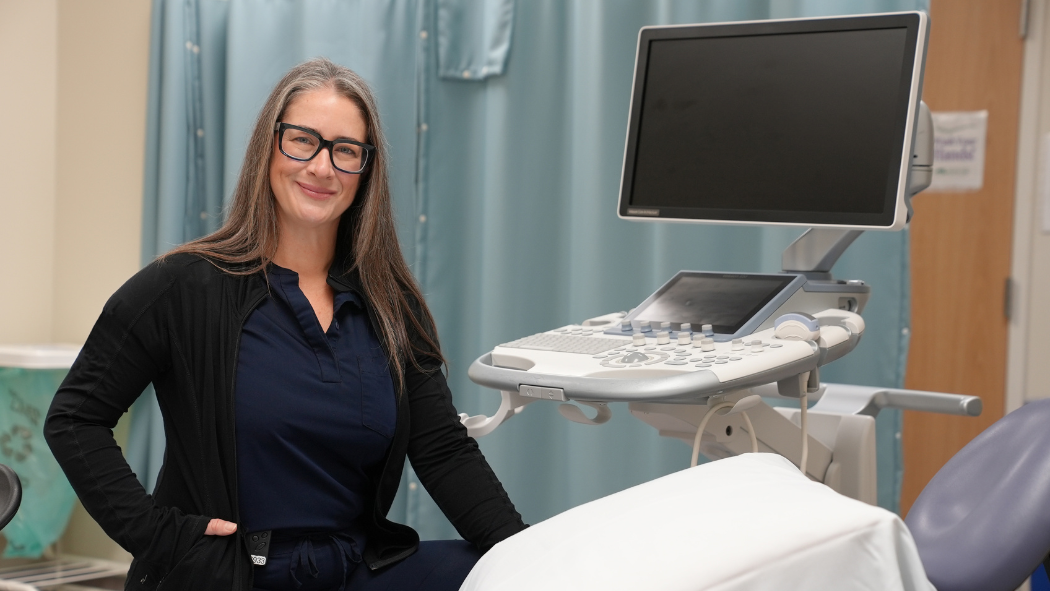
Pictured: Dr. Erin Lovett in the new Women's Minor Procedure Room
October 7, 2025
London Health Sciences Centre (LHSC) is raising the standard of women’s health care with the introduction of the Women’s Minor Procedure Room (MPR) – a dedicated space designed to prioritize patient comfort and ease the pressure on operating rooms.
“For decades, pain during gynecological procedures has been underrecognized and undertreated,” says Dr. Erin Lovett, obstetrician/gynecologist (OBGYN) at LHSC. “From IUD insertions to endometrial biopsies, patients have largely been expected to 'tough it out,’ with limited options for pain relief. Our new MPR is changing that narrative.”
A more compassionate, patient-centered approach
The Minor Procedure Room offers a range of procedures, including IUD insertions and removals, biopsies, pap smears and pelvic exams for those with a history of trauma.
Previously, these procedures were done in a clinic or operating room (OR), where options for pain management, outside of anesthesia, were limited to lidocaine cream, cervical blocks or NSAIDs. While these worked for some patients, they were inadequate for others.
The MPR provides a much-needed middle ground. Here, patients receive conscious sedation, allowing them to stay awake but relaxed.
“We know the fear of pain and discomfort can cause patients to avoid care,” says Dr. Lovett. “Now we’re able to tell them we have more choices to help keep them comfortable.”
The MPR is equipped with the same monitoring tools as a standard OR but is designed for smaller, less intensive procedures. Patients benefit from a more flexible experience: they don’t need to arrive early, can eat and drink lightly before their appointment, and are typically ready to leave within 30 minutes of the procedure’s completion.
While most procedures only take five to 15 minutes, appointments are scheduled with enough time for patients to go at their own pace. The entire visit – from check-in to recovery – can take as little as an hour, which is significantly less time compared to the half- or full-day commitment required in a traditional OR setting.
The space itself is also intentionally designed to feel more personal. Instead of a full surgical team, the MPR is staffed by just a physician and a nurse, creating a quieter, more relaxed environment.
“It’s a less daunting experience overall, and that helps put patients at ease while giving them a sense of control over their bodies and care,” explains Dr. Lovett.
Easing the strain on the health-care system
Beyond improving patient experience, the Minor Procedure Room is alleviating pressure on LHSC’s operating rooms. By shifting appropriate cases out of the OR, the MPR frees up valuable surgical time for patients with more complex needs, helping to reduce surgical wait times.
Previously, even procedures like retrieving IUD strings had to be scheduled into the OR. Now, with the MPR in place, wait times for minor gynecological procedures range from one week to three months, depending on the level of urgency.
Breaking barriers and building equity
The Minor Procedure Room is also closing longstanding gaps in gynecological care by addressing systemic inequities and gender bias, particularly around how women’s pain is often minimized or dismissed as ‘part of the experience.’
“We’re always exploring innovative ways to better manage women’s pain,” says Dr. Lovett. “This space is our way of saying, ‘we see you, we hear you, and we’re committed to making this experience less painful for you.’”
While most patients are referred to the MPR by an LHSC gynecologist, those who are seeking an IUD with sedation can self-refer through LHSC’s Rapid Access IUC and Implant Centres of Excellence (RAIICE) Clinic. To book, call 519-685-8355 or email birthcontrol@lhsc.on.ca.
Looking ahead
Building on the early successes of the Women’s Minor Procedure Room, LHSC is working to expand the range of procedures offered within it to include endometrial ablations and hysteroscopies. These additions, which are currently done in an OR, would allow more patients to receive timely, comfortable treatment in a less intensive setting.
“The Minor Procedure Room is more than just a space,” says Dr. Lovett. "It represents a shift in the culture of gynecologic care from one of endurance to one of empathy. That’s the kind of experience every patient deserves.”
